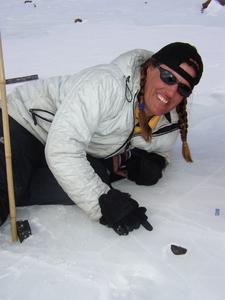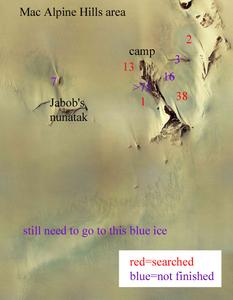
|
|
26 December, 2002
This is Nancy Chabot, guest-posting for Andy. I've been meaning to post for
a while, but well, I guess my excuse is that I've been busy. This is my
third season in Antarctica as part of ANSMET, but for me, this time is a
very new experience. This time, I'm the lead scientist for our field team.
What does that mean exactly? I'm a research scientist at Case Western
Reserve University, working with Ralph Harvey, the principal scientist of
ANSMET. For months before the field season, we looked at aerial photos and
satellite images, planning out the goals for this season. Now that we're
here, it's my job to try and carry out those goals. Basically, along with
Jamie, I decide what we do from day to day.
So, how are those goals coming so far? I'm really pleased with how much
progress we've made to date, though of course there is still a lot to do.
Before our traverse, we recovered 90 meteorites from near Goodwin nunataks.
Here at Mac Alpine Hills, we've completely finished off systematically
searching some nearby blue ice fields. We've identified a moraine with
greater than 75 meteorites in it that we need to finish searching. On our
first visit to Jacobs Nunatak, we went to scope out the area and returned
with 7 meteorites. Just today, after getting some mail from a visiting twin
otter plane, we collected 26 meteorites at a local moraine. Other blue ice
fields and moraines remain to be visited. The over 160 meteorites we have
recovered from the Mac Alpine Hills area so far have also been different
types. We'll have to wait until after the field season before the
meteorites are properly identified and classified. However, different types
of meteorites in such a small area suggest some sort of concentration
mechanism for the meteorites is at work and that the meteorites are not all
samples of the same fall.
Below is an image that shows generally what locations we have searched and
points out some areas we'll be heading to in the near future. The numbers
of meteorites found in different areas are noted on the image. You'll
notice some ice fields have many meteorites while others have few to none.
We're still working to try and fully understand why very similar looking
locations have very different meteorite concentrations. It's a bit of
science in progress.
My job could be very difficult. I could have to order people around, nag
them to get jobs done, and just be generally unpleasant I suppose. But the
reality is, we have a great team with very motivated and hard working
individuals, all of whom are excited about hunting for meteorites. That
makes my job so much easier. And of course, it means we all have a lot more
fun too!
So, a common question I get is why I keep coming back for ANSMET seasons.
There are a number of reasons. For me, I find it very rewarding to be part
of such a scientifically important program like ANSMET, a program which
recovers thousands of meteorites and makes them available to scientists
around the world. I also enjoy the outdoors and feel lucky to be able to do
work in Antarctica. Antarctica is a stunningly beautiful place that can
take your breath away just as much on day 42 as it did on day 1. Along with
the science and the scenery, the people really do make the ANSMET
experience for me. Sharing such a unique time together makes for special
friends.
On a personal note, I just want to say hi and happy holidays to my mom and
dad and sister. Thanks for the Christmas gifts! Linda and I already
finished off a package of the gummy bears and did the puzzle. Though we all
had a really nice Christmas here in the field, I thought about our little
family Christmas back in CA and missed you!!

Nancy Chabot collecting one of many meteorites (photo by Jamie Pierce).

A mosaic of aerial photos shows the general Mac Alpine Hills area. Our camp location is labeled in the image. The numbers refer to the numbers of meteorites found on different blue ice fields or in moraines. Red numbers indicate areas that have been completely systematically searched. Blue numbers indicate areas where we have found meteorites but have yet to finish searching the area. Some blue ice, such as that in the lower portion of the image, we still have to visit. The image is oriented with north at the top of the image, and the image is about 10 km wide.
Contact the TEA in the field at
.
If you cannot connect through your browser, copy the
TEA's e-mail address in the "To:" line of
your favorite e-mail package.
|
